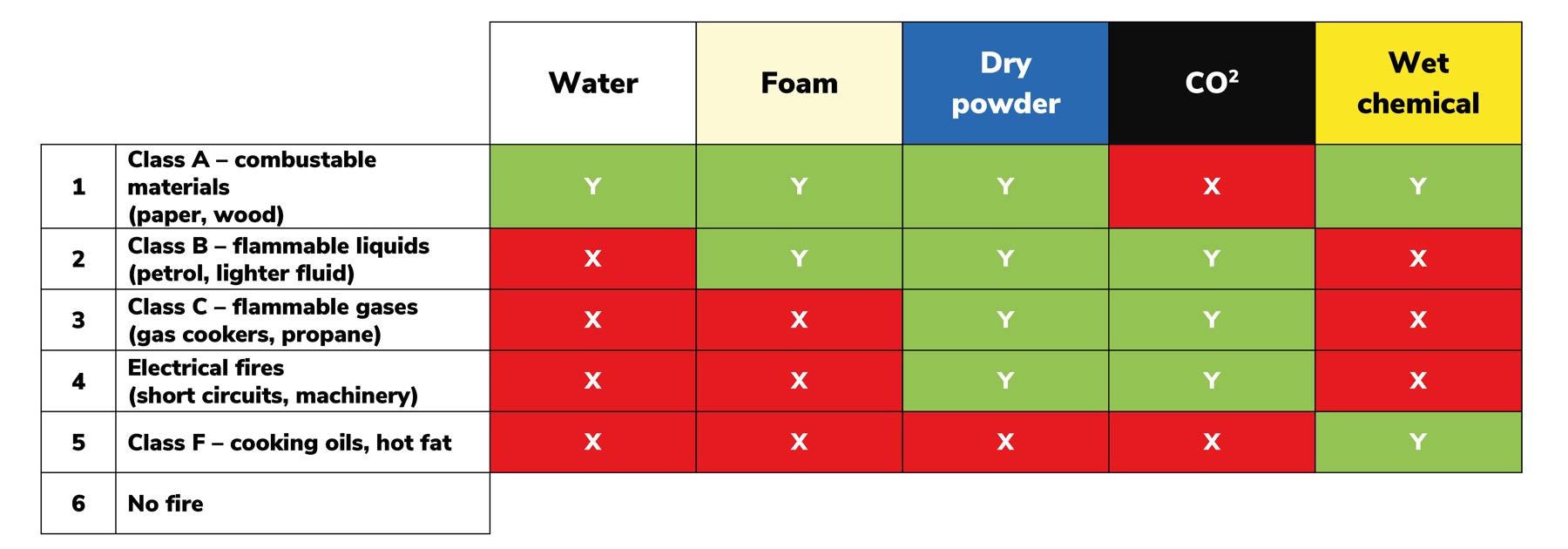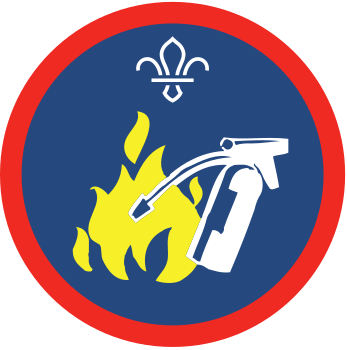Extinguisher distinguishers
You’ll need
- Scissors
- Sticky tack
- Dice

Before you begin
- Cut up the ‘Types of extinguisher’ labels. You may want to attach them to coloured cones or drinks bottles to make it easier to imagine them in real situations.
Sort the facts
- Everyone should gather in a circle.
- The person leading the game should lay out the ‘Types of extinguisher’ labels in the middle of the circle.
- The person leading the game should use the table above to help everyone understand the different kinds of fire extinguisher and when they should be used.
- Everyone should chat about fire blankets. They can be used to put out fires in the kitchen (for example, cooking oil, saucepans, frying pans, and waste bins) as well as clothing fires. When you cover the fire with the fire blanket, it cuts off the fire’s supply of oxygen.
Play the game
- The first player should roll the dice. The number they roll tells them what type of fire they’ve found:
One is Class A combustible fires. Two is Class B flammable liquids. Three is Class C flammable gases. Four is Electrical fires (caused by short circuits and electric currents). Five is Cooking oils and hot fats. Six is No fire (so the player doesn’t need a fire extinguisher and can pass the dice on). This information’s also on the ‘Which one when?’ table.
- The player should choose the right ‘Types of extinguisher’ label from the middle of the circle. If they get it wrong, they should guess again until they’re right.
- Once they’ve found the right label, they should put it back in the middle of the circle and pass the dice to the player on their left.
- Everyone should keep rolling the dice, choosing the right fire extinguisher, and passing the dice on until everyone’s had a turn. How quickly can the group get around the circle?
Check the meeting place
- Everyone should look around the meeting place and find the fire extinguishers.
- Everyone should know what each extinguisher can be used for. Which would they use if there was an electrical fire? What about if wood was on fire?
Reflection
This activity was all about developing skills and problem-solving. It’s important to make the right decision quickly (but calmly) if there’s a fire. Different fire extinguishers are designed for different fires – it’s important to use the right one. They’re helpfully labelled with their type and symbols and words that show the fires they can and can’t be used on. How did people choose their extinguisher in the game? In a real situation, it’s more important to get it right. How could people make sure? In emergencies, it’s often important to make the right decision quickly. What other safety features help people do this? People may think about fire exit signs that make it obvious where to escape.
Remember, fire extinguishers should only be used in an emergency to help you escape. Never try to put out a fire yourself unless you need to (even if you think you know which extinguisher to use).
Safety
All activities must be safely managed. You must complete a thorough risk assessment and take appropriate steps to reduce risk. Use the safety checklist to help you plan and risk assess your activity. Always get approval for the activity, and have suitable supervision and an InTouch process.
- Active games
The game area should be free of hazards. Explain the rules of the game clearly and have a clear way to communicate that the game must stop when needed. Take a look at our guidance on running active games safely.
Add another dice into play, so more than one person’s rolling at once for an added challenge.
Remove an extinguisher label or two to narrow down the choices. What would people do if the right extinguisher weren’t available? Alternatively, add in extra factors about the situation, for example, it’s an electrical fire but you’re in a small enclosed space with no ventilation. What’s the right thing to do now?
Put the extinguisher labels somewhere everyone can reach – this may mean playing around a table, or passing them along with the dice.
Being in a real fire can be traumatic. Before you start this activity, think about if anyone’s ever experienced a real fire – you may want to give people the chance to let you know if they’re not comfortable taking part (or if you need to avoid a particular scenario, or make other adjustments such as having a safe space to retreat to). Everyone should know that they can stop at any time if they don’t want to carry on.
This activity’s about learning the skills to be safe in the unlikely event of a fire. People should leave feeling empowered and confident, not anxious or scared. Make sure you have time to chat at the end.
All Scout activities should be inclusive and accessible.
Reach out to your local fire service. It’s usually possible to arrange a visit where someone can talk in more detail about fire extinguishers (and even demonstrate some in action).
